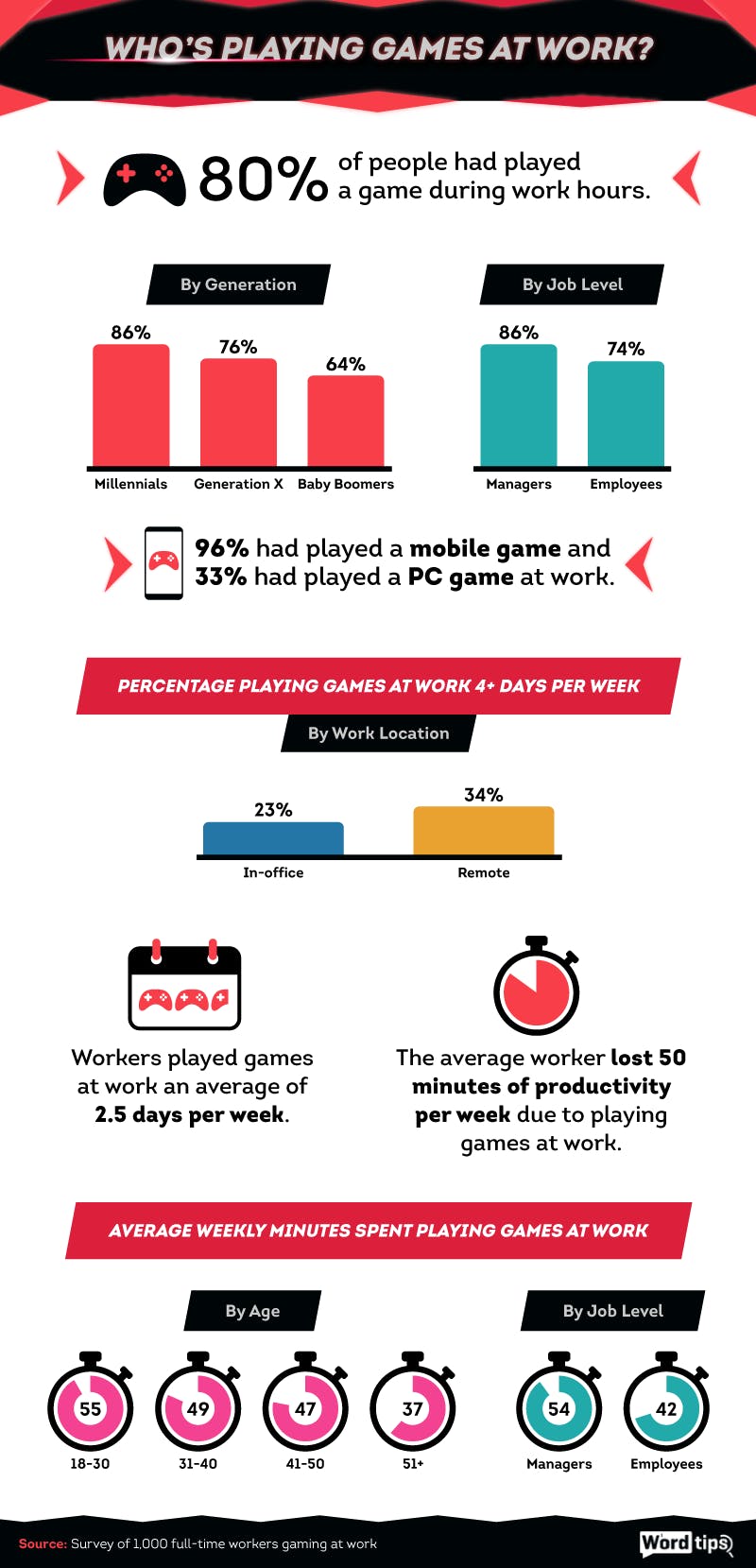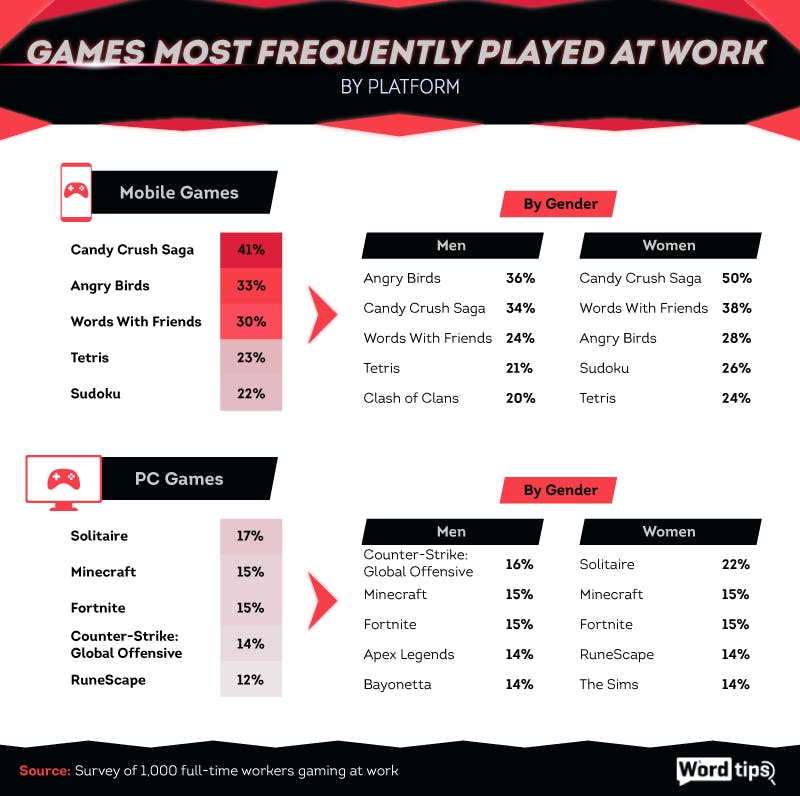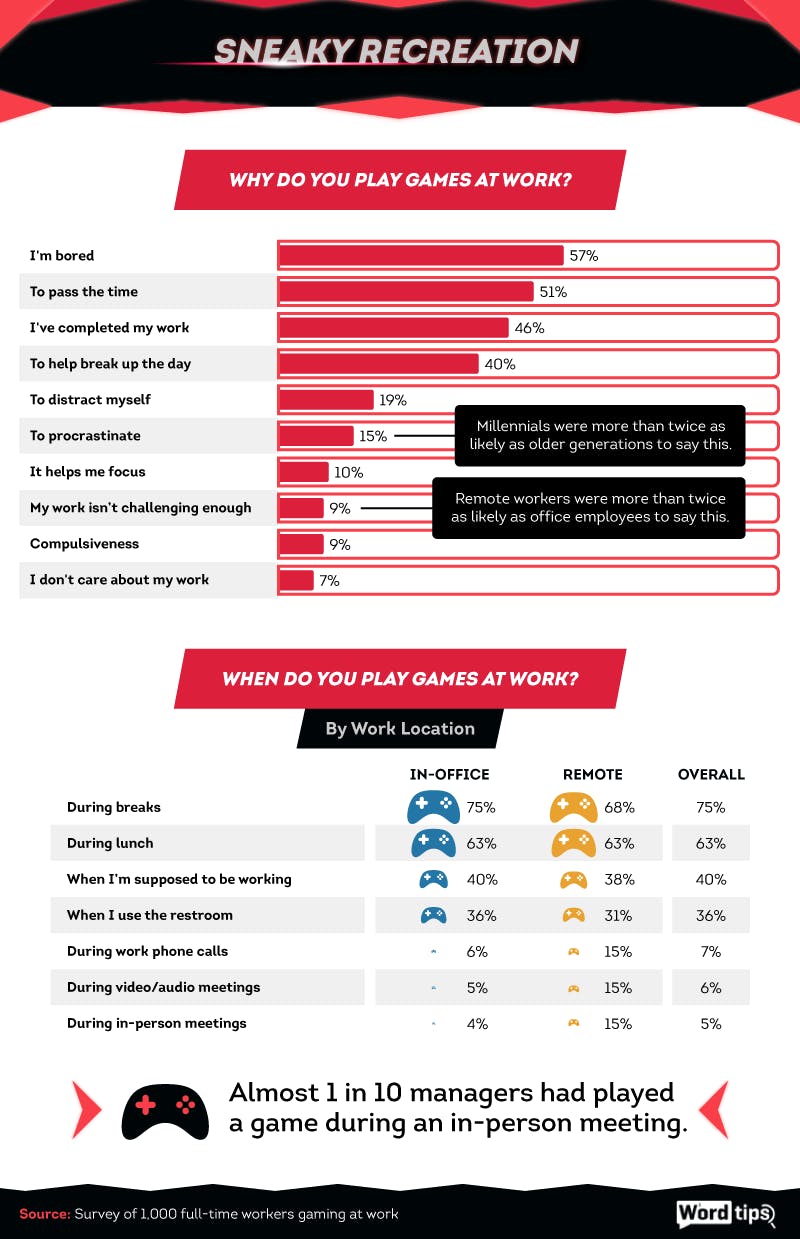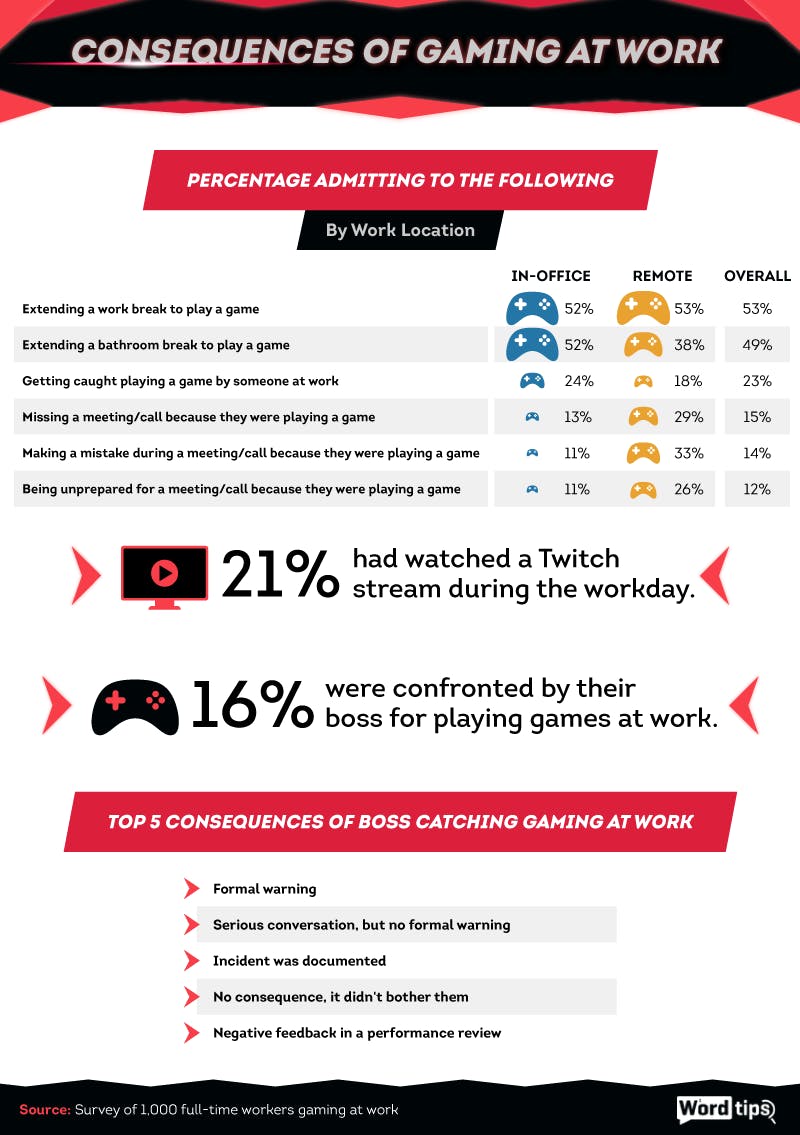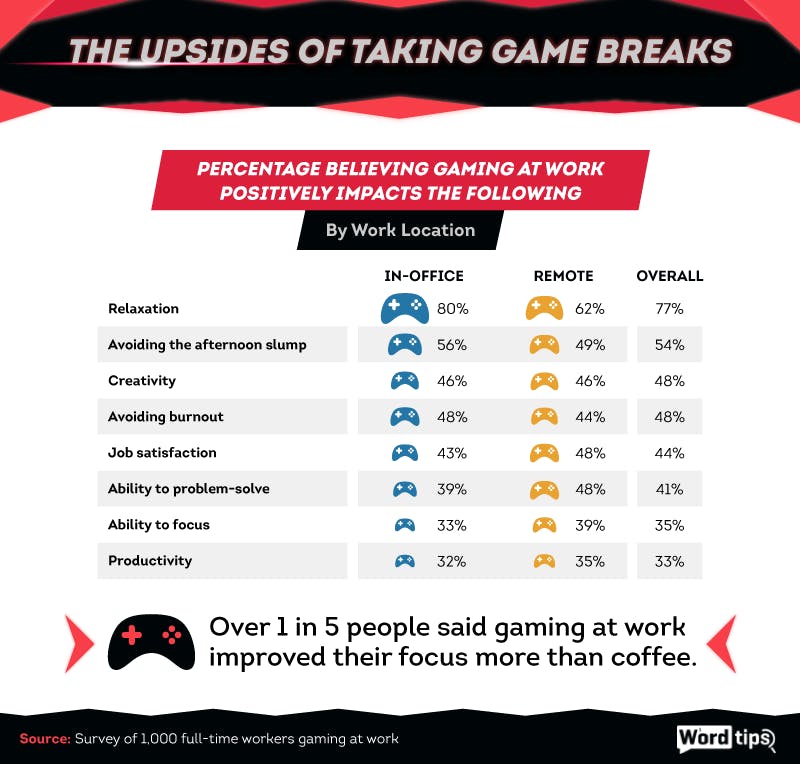Gaming at Work
Exploring the Games People Play at Work and Their Impact on Job Performance
Last update: 3/2/2023

The “work hard, play hard” philosophy usually means you’ve got to work hard first to earn your play later. But in the American workplace, the two might be happening simultaneously. It turns out that gaming at work is pretty common and might be a beneficial behavior in the modern workplace.
We spoke to 1,000 full-time workers to better understand their gaming habits at work. What we found seemed to run counter to the reputation of the American workforce: long hours, desk lunches, and significant burnout. If the American workforce generates such an incredible volume of output, could gaming be providing the assist? Read on to find out.
Everybody’s Doing It
If you think gaming isn’t happening in your office or that you’re the only one sneaking it in, you’re sorely mistaken. The overwhelming majority of employees had played games when they were supposed to be working: 80% of respondents said they had gamed at work, and 96% of those people had played games on their phones. Not only did managers and supervisors join in on the action, but they were more likely than their subordinates to engage in at-work gaming. These higher-ups even spent longer, on average – 54 minutes every week – playing games when they should have been working.
That said, the percentage who were willing to play games on a PC screen dropped to just 33% of workers. Perhaps this smaller group of workers is able to stealthily gameplay on their work computers with the use of certain shortcuts and popular apps that help them avoid getting caught.
Younger generations and remote workers (two demographics with a lot of overlap) were also more likely to be found gaming instead of working. Millennials were the most likely generation to play games during work hours, while remote employees were the most likely type of worker to game four or more days during the workweek, compared to the 2.5-day average. That said, remote workers are typically more productive than their in-office counterparts, so maybe their gaming isn’t as detrimental to the workday as it sounds!
Game by Game
Next, our study sought to explore any gender-based differences when it came to gaming at work. Most commonly, women wanted to play Candy Crush Saga (50%) and Words With Friends (38%), while men were most interested in Angry Birds (36%) and Candy Crush Saga (34%). Even though these games can be discreetly played on a mobile phone, 22% of women played Solitaire on their computers, while just 16% of men took the same risk to play Counter-Strike. In general, work stress is thought to weigh more frequently on men. Perhaps they’re not taking sufficient game breaks in the way women are.
Gaming Motivations
When we asked respondents why they gamed so much (typically on smartphones), their responses were mostly logical and purposeful – a response to long workdays rather than a mindless decision.
For instance, nearly half of respondents said they played games because their work was already finished. Another 57% said they were bored, and 51% said they needed something to pass the time. Remote workers were even more likely to feel their work wasn’t challenging enough and relied on games for stimulation.
In light of these findings, one could argue that gaming is filling in the gaps that are often inherent in an eight-hour workday. Previous research has already demonstrated the amount of unnecessary time chewed up by the 40-hour workweek, and our study has now revealed how some of that time is being filled.
Facing the Consequences
Despite how many employees spent time gaming at work, there didn’t seem to be too much risk involved. Bosses didn’t catch or confront their subordinates very often. And when people did get caught, the consequences weren’t terrible: In fact, one of the most common consequences to being caught was actually no consequence at all. More often, workers caught gaming were issued a formal warning (57%) or had a serious conversation without a formal consequence (41%).
Even though consequences were either minor or nonexistent, a small number of workers admitted to some pretty risky gaming behaviors. Fifteen percent said they missed a meeting or call by getting too wrapped up in a game, while 14% made a mistake during a meeting or call because they were gaming at the time. Another 12% found themselves completely unprepared for a meeting or call due to gaming.
Playing for the Positives
The majority of workers experienced positive benefits as a result of gaming during work. To name a few, 80% of in-office workers said they felt more relaxed, and 54% said that games alleviated the afternoon slump. Another 48% overall said feelings of creativity and burnout were both positively impacted by gaming at work. More than 1 in 5 even compared gaming to coffee, saying their focus was improved by games.
The list goes on: Productivity, the ability to problem-solve, and even job satisfaction all improved after a bit of gaming time. If you’re one of the 83% of Americans who experience workplace stress, you might want to give a few minutes of gaming a try. In fact, word games paired with helpful tools like a Scrabble cheat or anagram solver can lead to improved vocabulary and communication skills.
Game Face
Ultimately, the data showed that gaming and work go hand in hand. American employees and their managers are spending hours each month playing games when they’re technically supposed to be working. Yes, sometimes they did procrastinate or avoid responsibilities – but often, gaming helped people relieve stress and feel more focused once they did return to work.
The positives related to gaming at work appeared to outweigh the negatives. And the value of a break, whether gaming-related, cannot be underestimated. American employees are overworked and stressed much of the time. A break is likely well-deserved, and it’s completely up to you if you’d like to use this time to play games. According to the data, everybody else is doing it!
Methodology and Limitations
We used Amazon Mechanical Turk to survey 1,000 full-time workers about their experiences with playing games during work, as well as how it affected their work performance. For respondents to be included in our data, they were required to complete the entire survey, take the survey only once without multiple attempts, and pass an attention-check question in the middle of each survey. Participants who failed to do all of these were excluded from the study.
Of all respondents, 53% were men, 47% were women, and less than 1% identified with a nonbinary gender. Sixty-three percent of respondents were millennials (born 1981 to 1997); 26% were from Generation X (born 1965 to 1980); 8% were baby boomers (born 1946 to 1964); 3% were Generation Z (born 1998 to 2017); and less than 1% was from the silent generation (born 1928 to 1945). The average age of respondents was 36 with a standard deviation of 12 years. Sixty-five percent of respondents managed other employees, and 35% did not. Seventy-three percent worked from an office/job site, 12% worked remotely, and 16% worked half remotely and half from an office/job site.
The data we are presenting rely on self-reporting. There are many issues with self-reported data. These issues include, but are not limited to, selective memory, telescoping, attribution, and exaggeration. In finding averages of quantitative values, we removed outliers so that the data were not exaggerated.
Fair Use Statement
The secret is out: The data shows we’re all gaming at work. You’re welcome to share the news, but you must be sure your purposes are noncommercial, and you link back to this page.
